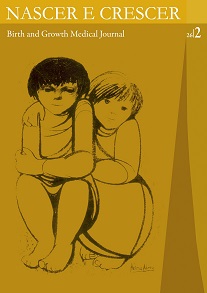ACUTE DISSEMINATED ENCEPHALOMYELITIS – A CASE SERIES
DOI:
https://doi.org/10.25753/BirthGrowthMJ.v26.i2.9409Keywords:
Acute Disseminated Encephalomyelitis, pediatrics, magnetic resonance imagingAbstract
Background: Acute disseminated encephalomyelitis (ADEM) is a demyelinating monophasic disorder of the central nervous system characterized by diffuse neurologic signs and symptoms coupled with multifocal demyelinating lesions on neuroimaging.
Aims: To describe the epidemiology, symptoms and signs, laboratory features, neuroimaging, treatment and outcome in a pediatric cohort with the initial diagnosis of ADEM.
Methods and Materials: A retrospective review, between 2010-2015, of children/adolescents admitted at a level II hospital.
Results: Eleven cases were identified with male predominance and ages between 8 months and 16 years. Seven patients presented in winter/spring. More than half of the cases had a recent infectious disease. Patients presented most often with motor deficits, cranial neuropathy and stiff neck. All patients had spinal fluid abnormalities. A definitive microbiologic diagnosis was established in two children with Epstein-Barr virus disease and probable/possible diagnosis in two children with previous rotavirus disease or varicella. Brain magnetic resonance imaging (MRI) identified multifocal lesions in every case. All patients were treated with corticosteroids, and two were also treated with human immunoglobulin. There was one case with multiphasic ADEM (after one year follow-up) and two cases developed criteria of multiple sclerosis (MS). All patients survived. Two patients had neurologic sequelae. The differential diagnosis between ADEM and MS at first presentaion may be challenging.
Conclusions: Our case series suggests that infections are associated with the etiology of ADEM. MRI was the neuroimaging study of choice for diagnosis and follow-up. Prognosis was excellent. It remains difficult to differentiate ADEM and multiple sclerosis.
Downloads
References
Mengel T, Kieseier BC, Nessler S, Hemmer B, Hartung HP,
Stuve O. Acute disseminated encephalomyelitis: an acute hit
against brain. Cur Opin Neurol 2007; 20:247-54.
Mariani Foundation Paediatric Neurology - Immune-mediated
disorders of the Central Nervous System in children. Vol. 10.
Eastleigh: John Libbey & Company; 2002; 29-69.
Menge T, Hemmer B, Nessler S, Wiendl H, Neuhaus O,
Hartung HP, et al. Acute disseminated encephalomyelitis: An
Update. Arch Neurol 2005; 62:1673-80.
Leake JA, Albani S, Kao AS, Senac MO, Billman GF,
Nespeca MP, et al. Acute Disseminated encephalomyelitis
in childhood: epidemiologic, clinical and laboratory features.
Pediatric Infect Dis J 2004; 23:756-64.
Banwell B, Kennedy J, Sadovnick D, Arnold DL, Magalhaes
S, Wambera K, et al. Incidence of acquired demyelination
of the CNS in Canadian children. Neurol 2009; 72:232-9.
Tenembaum S, Chitnis T, Ness J, Hahn JS. Acute
disseminated encephalomyelitis. Neurol 2007; 68:23-36.
Erazo-Torricelli R. Encefalomielitis aguda disseminada en la
niñez. Rev Neurol 2006; 42:75-82.
Silvia MT, Licht DJ. Pediatric central nervous system infection
and inflammatory white matter disease. Pediatr Clin North
Am 2005; 52:1107-76.
Murthy SN, Faden HS, Cohen ME, Bakshi R. Acute
disseminated encephalomyelitis in children. Pediatrics
; 110:e21.
Stonehouse M, Gupte G, Wassmer E, Whitehouse WP. Acute
disseminated encephalomyelitis: recognition in the hands of
general pediatricians. Arch Dis Child 2003; 88:122-4.
Krupp LB, Tardieu M, Amato MP, Banwell B, Chitnis T, Dale
RC, et al. International Pediatric Multiple Sclerosis Study
Group criteria for pediatric multiple sclerosis and
immune-mediated central nervous system demyelinating
disorders: revisions to the 2007 definitions. Mult Scler.
; 19:1261-7.
Downloads
Published
How to Cite
Issue
Section
License
Copyright and Authors' Rights
All articles published in Nascer e Crescer - Birth and Growth Medical Journal are Open Access and comply with the requirements of funding agencies or academic institutions. For use by third parties, Nascer e Crescer - Birth and Growth Medical Journal adheres to the terms of the Creative Commons License "Attribution - Non-Commercial Use (CC-BY-NC)".
It is the author's responsibility to obtain permission to reproduce figures, tables, etc. from other publications.
Authors must submit a Conflict of Interest statement and an Authorship Form with the submission of the article. An e-mail will be sent to the corresponding author confirming receipt of the manuscript.
Authors are permitted to make their articles available in repositories at their home institutions, provided that they always indicate where the articles were published and adhere to the terms of the Creative Commons license.


